Exploring Mount Holyoke as a living laboratory
Transforming Mount Holyoke’s natural and built landscape into an exciting destination for hands-on multidisciplinary undergraduate research and teaching
Deep in the woods on the path around Upper Lake students stretch and move, interacting with the landscape. On the other end of campus, students measure water levels of Stony Brook as another group meets to review energy use data from residence halls. All of these students are engaging — with faculty and staff — in the campus as a living laboratory.
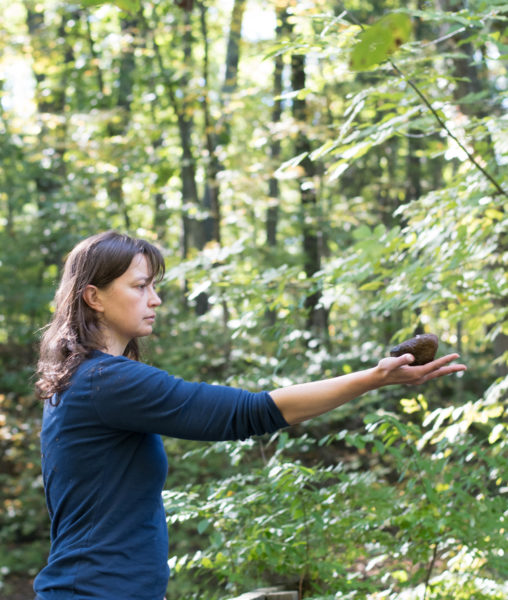 For the students in Terre Parker Vandale’s ’02 site-specific modern improvisation dance class, the Mount Holyoke campus transforms into a stage. Its quiet jewels, from crooked streams to the electric green expanse framing the library, become a platform for expression. Students roam toward any corner of nature that moves them, connecting with the earth and sometimes closing their eyes. The natural world becomes their partner, drowning out internal chatter or the hum of cars along Route 116.
For the students in Terre Parker Vandale’s ’02 site-specific modern improvisation dance class, the Mount Holyoke campus transforms into a stage. Its quiet jewels, from crooked streams to the electric green expanse framing the library, become a platform for expression. Students roam toward any corner of nature that moves them, connecting with the earth and sometimes closing their eyes. The natural world becomes their partner, drowning out internal chatter or the hum of cars along Route 116.
The course, Site-Specific Intermediate/Advanced Modern Improvisation, focuses on environmental dance, where students’ creativity is shaped, literally, by their surroundings.
“The environment is dancing with us. It’s moving all the time,” says Vandale, a Five College visiting artist who began focusing on environmental dance while a student. “The landscape at Mount Holyoke is where I developed my practice, because it’s beautiful and inspiring,” she says.
While the use of campus for applied learning resonates across disciplines — such as for students in Vandale’s dance class — it’s a crucial underpinning of Mount Holyoke’s robust tradition of championing the sciences. About 30% of students major in STEM — science, technology, engineering and math — significantly higher than the proportion of women who major in math and science at comparable coeducational institutions.

A student in Terre Parker Vandale’s ’02 improvisational dance class
In fact, the campus has a longstanding history of use as a field station for studying the physical environment and contains several environmental monitoring sites. Measuring everything from weather to forest health to water quality in the lake system, faculty, staff and students from departments such as biological sciences, geology and geography, and environmental studies integrate learning in these field sites into labs, course projects and independent research.
A Place, but Also a Mindset
The current vision for the Campus Living Laboratory (CLL) has been advanced by the Miller Worley Center for the Environment, which was established in 1998 and then endowed in 2010 with a generous gift from Leslie Miller ’73 and Richard Worley. Other alumnae were also instrumental in its founding, including Nancy Skinner Nordhoff ’54, Helen Appell Norton ’54 and Sarah Miller Coulson ’75, as well as Mary Jean Ahern Hale ’67, whose support has been instrumental to the environmental internship program. The Center was founded to make environmental literacy a central part of students’ education. The CLL crystallizes that vision. It is part of a campus sustainability initiative set forth by the Board of Trustees that, in addition to endorsing food justice and sustainability and the CLL as key priorities, established the goal of becoming a carbon-neutral campus by 2037. (Carbon neutrality is achieved by reducing the amount of carbon released into the atmosphere — making the College a netzero contributor of greenhouse gases — and will be accomplished mainly by converting to renewable energy sources, increasing energy efficiency, energy conservation and supporting other local and regional efforts.)
The CLL is a physical location — the campus as a whole — but it’s also a philosophy. It’s a strategic initiative for Mount Holyoke, focusing on experiential learning across the College’s 700 acres of natural and developed landscape for classwork, hands-on research and independent projects.
Through this framework, the Campus Living Laboratory Initiative was born — manifesting in coursework, research projects and work on sustainability initiatives that unite students, faculty and staff in the limitless possibilities Mount Holyoke offers for academic exploration and rigor. Faculty devise lab exercises to study water levels at Stony Brook and Project Stream. Creative writing students use the campus to inspire descriptions of outdoor settings. Biology students study invasive species. And music students record the sounds of campus for a class on acoustic ecology.
The Right Idea in the Right Setting
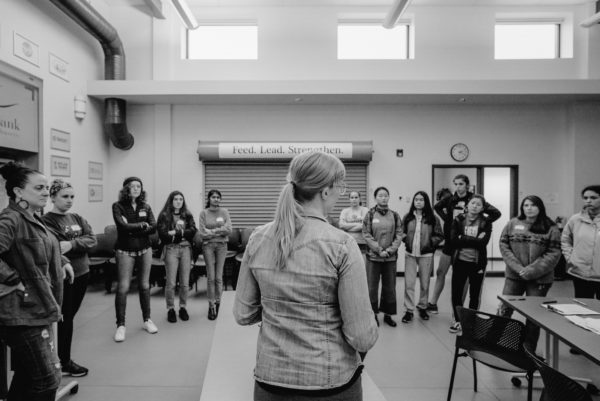
Students in Jennifer Albertine’s environmental studies food justice class visit the Food Bank of Western Massachusetts in Hatfield.
The CLL comprises natural ecosystems, the built environment — buildings and infrastructure, a four-mile network of trails, and an online database housing decades of student and faculty environmental monitoring information culled from 15 permanent water sampling stations, five weather stations and ecological field sites across campus, such as the Restoration Ecology Program’s restored wetland site and the forest on Prospect Hill.
Mount Holyoke is a wholly unique setting for the endeavor, says Leszek A. Bledzki, senior research associate at the Miller Worley Center. Bledzki, an ecologist, forester and limnologist, praises the CLL as a differentiator.
At so many other schools, students travel to conduct fieldwork at remote venues. Here, rich opportunities exist right outside students’ residence hall rooms. “At Mount Holyoke, we have nine different ecosystems that you can reach within a 10-minute walk, from meadows and forests to lakes, streams, rivers and wetlands,” Bledzki says.
Faculty say that the CLL combines Mount Holyoke’s most powerful assets — its stunning campus and its research brainpower — at a pivotal time in history.
“We’re providing an opportunity for faculty, staff and the community to use the natural and built environment for learning,” says Catherine Corson, Leslie and Sarah Miller Director of the Miller Worley Center for the Environment. “We have a strong emphasis on the undergraduate research experience, and the CLL provides opportunities for students to connect local classroom and research experiences to global problems such as climate change and water quality. This is an opportunity for students to do this work right on campus.”
Classes with Real-World Repercussions
Students in visiting lecturer Jennifer Albertine’s campus sustainability class engage with the environment just as intimately as those in Vandale’s dance class. In this case, though, they’re not wrapping themselves around logs or wading into streams. They might, however, monitor water usage in residence hall bathrooms or pop into empty classrooms, determining where to recommend the installation of automatic light switches.
With the carbon-neutral initiative in mind, Albertine wanted to give students a practical way to make a difference in service of a clear-cut, actionable goal. The spring semester kicked off with a critical reading of the sustainability initiative. Students highlighted where new technology could achieve the goals, focusing on topics such as energy use, water use and waste. “This is a problem-solving class, driven by students,” Albertine says.
Budding researchers then conducted behavioral surveys by residence hall to assess sustainability practices: How long do students linger in the shower? Would they mind using community fridges instead of energy-sapping mini ones?
Then they identified residence halls in need of more education, visiting in person to discuss techniques to reduce energy consumption. For example, students might explain to classmates how lower energy bills could translate to cost savings elsewhere on campus. They also staked out common areas such as the Community Center, talking to classmates about their consumption practices as they breezed through the space.
“Students engage on a personal basis. In the past, other student groups on campus found that simply hanging signs on campus didn’t work. This is face-to-face engagement,” says Albertine, with real benefits.
They are developing their projects with an eye toward implementation. Students will meet with the Center’s Associate Director for Sustainability Nancy Apple and others on campus as they develop their recommendations to discuss feasibility, costs and implementation strategies.
Hands-On Research, Right Outside Your Residence Hall

Alan Werner
Geology professor Al Werner has taught at Mount Holyoke for 21 years, but the CLL provides a new and necessary framework for his longtime research. He works side by side with students researching campus streams and subsurface ground water.
This year, he established an automated gauging station on Stony Brook, where a water-level sensor measures the stream’s height as it cascades over the dam by the Willits-Hallowell Center. This way, Werner is able to determine how the stream responds to rainfall and seasonal precipitation fluctuations. Werner works with a student to measure the volume of water tumbling over the dam to better understand the relationship between stream height and discharge.
Other research sites include a 100-foot well behind the Kendall Sports and Dance Complex, where Werner monitors groundwater levels.
“We can go out with a class, put a pump into the well, and pump water out and see how the well responds to that pumping. Depending on how much it lowers and the rate at which it recovers, it can be used to calculate the hydraulic properties of the aquifer,” Werner explains. The data is used in his Groundwater Geology class — collected right outside the classroom, not at some distant venue.
“If you have a living lab facility located off campus, it’s less useful on a daily basis. [The CLL] makes it more accessible. It makes it more usable. And it takes advantage of our wonderful campus,” Werner says.
Data from Werner’s work and that of other CLL projects is housed (and in some cases livestreamed) in the Institutional Data Archive (IDA) and the Campus Research Center, online resources full of environmental information, much of it publicly searchable. The IDA stores data from more than two dozen courses and independent student research projects on environmental phenomena — much of it spearheaded by Bledzki — focusing on monitoring, sustainability and history. Students can use it for their work and upload their own research, too. The Campus Research Center contains information from the current year, with frequently updated data sets from ongoing initiatives. It’s a concrete way to see — and leverage — research unfolding in close proximity.
Preparing Students for Careers
The CLL also provides a framework for Mount Holyoke’s broader sustainability initiatives, allowing students to take on professional-level responsibilities to meet important goals.
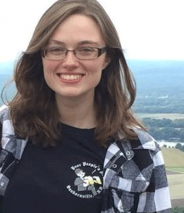
Student researcher
Shannon Seigal ’19
Shannon Seigal ’19 graduates this year, but she already does professional-level work, in the past as a campus Eco-Rep and a student representative to the Sustainability Task Force, and currently as a sustainability fellow at the Miller Worley Center. In fact, it was Seigal who suggested that the goal year for carbon neutrality be 2037, the College’s bicentennial.
One of her largest projects focused on greenhouse gas emissions.
“Generating a comprehensive greenhouse gas inventory allows us to look specifically at our climate impact and compare our emissions to those of other institutions and protocols like the Paris Climate Agreement,” she explains.
As a student employee at the Center, Seigal worked with Apple to collect energy consumption data from Facilities Management; faculty, staff and student commuter and travel data from Accounts Payable and Institutional Research; and refrigerant and chemical data from Facilities Management and Dining Services. She compiled the data using the Sustainability Indicator Management & Analysis Platform, which calculates the specific greenhouse gas emissions associated with campus sources.
It was a big job but a gratifying one, she says, because she was able to see her work’s direct impact: The updated inventory was presented to the Sustainability Steering Committee and the Board of Trustees. Mount Holyoke will use this information, updated every year, to decide where to focus reduction efforts in order to have the highest impact and to measure progress on emissions reductions over time. Seigal has also been instrumental in developing the new Green Workplace Program that calls on all campus workplaces to commit to sustainable practices.
“The Living Lab meant that I gained technical skills … in the environmental science field that complemented what I learned in liberal arts courses,” says Seigal. “Here, I got to take on a larger leadership role. I got to push myself — and push everyone else — in a way that undergraduate students don’t usually get to.”
Local Action, Far-Reaching Benefits
The CLL is also a crucial component of the South Hadley community. Through Associate Professor Kate Ballantine’s Restoration Ecology Program, students restored the long-neglected Project Stream, a waterway that feeds Mount Holyoke’s lake system and the Connecticut River beyond. The class found that the water quality of the stream was extremely poor due to nutrient pollution, so students planned and implemented a large-scale restoration project. Today, the stream, surrounding wetlands and a new boardwalk function as a research site, outdoor classroom and a public walkway. The site opened to the public in 2016 with a ribbon-cutting alongside local officials, and students often lead tours for groups of all kinds, including field trips with school groups from inner-city areas such as Holyoke and Springfield.
The class gives students the chance to interact with professionals. Students originally presented their background research and restoration proposal to the South Hadley Conservation Commission in 2013 and have since hosted several “Restoration Showcases” for the Commission, college leaders and the broader community.
Meanwhile, a Restoration Ecology Summer Scholars Program (RESSP) finished its fifth year in 2018. The free summer program, codeveloped by Jovanna Robinson-Hidas ’16, gives local high school girls hands-on experience in the field. Budding naturalists work with faculty and staff to monitor water quality, analyze soil, assess ecosystems for invasive species, tour local restoration sites, create an herbarium and work in small groups to design restoration plans.
Nia Bartolucci ’17 graduated with a degree in environmental studies and a concentration in ecosystem science, and she says the hands-on training she received through the CLL and Restoration Ecology Program prepared her for her first-choice Ph.D. program at Boston University.
As a student, Bartolucci collected vegetation, gas, water and soil data to inform the restoration of Project Stream. She also participated in RESSP, where she led tours, helped young students work in vegetation labs and staffed a booth at the local farmers’ market, sharing Mount Holyoke’s restoration projects with residents.
“I learned to convey the research we were doing to a wide array of audiences in an engaging way. Learning to not only conduct research but also to explain it and teach it has been an invaluable skill that has made me a stronger scientist,” she says.
Ballantine supervised Bartolucci’s thesis about greenhouse gas emissions in restored wetlands, which is currently in review for publication.
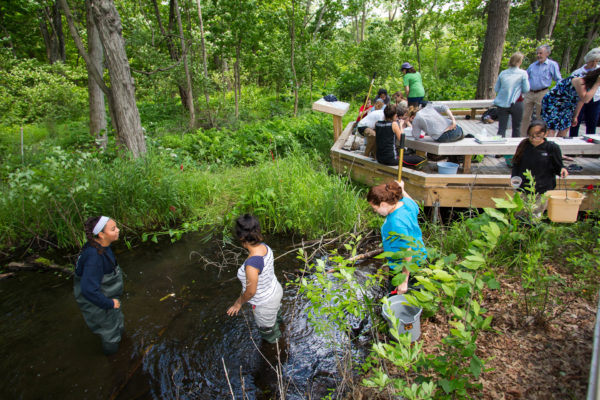
The heart of the College’s restoration ecology program,
Project Stream is a waterway that feeds the campus’s
lakes system. Students and faculty are working to plan
and implement a full site restoration.
“Having the opportunity to conduct independent research and to publish a first-author paper as a recent graduate from undergrad is rare, and I don’t think that I would have had the same opportunities at another school,” Bartolucci says.
As a doctoral student, she’ll study how climate change and other anthropogenic impacts affect the biogeochemistry and ecosystem function of coastal wetlands.
“I’m prepared for it because of the education, mentorship and opportunities I had at Mount Holyoke,” she says. “It makes science so accessible to everyone.”
The CLL provides an edge for students because it provides practical, hands-on experience in Mount Holyoke’s nurturing environment, Ballantine says.
“When students consider Mount Holyoke, one of the major draws is the Campus Living Lab. It provides an ideal opportunity to help them bridge the gap from being consumers of information to producers of original work,” she says. “The projects students have done in school until now often feel safe — students know the professor knows the answer, or that there are no real-world consequences anyway. By contributing to real-world projects with real-world consequences, students are committed at a deeper level, and in doing so develop skills, confidence, relationships and habits they can build on in all their future endeavors. At this stage they have the full attention of myself and other experts to guide them, but their work is truly original, and the outcomes are real. A privilege of being at Mount Holyoke is interacting with experts on real-world projects in a deeply engaged and collaborative way.”
“The Campus Living Lab is powerful because we’re framing the environment as the teacher,” says Vandale.
While dance might not seem like an intuitive match for environmental work, Vandale says it represents the inclusive, crossdisciplinary essence of Mount Holyoke. This broad appeal is essential as Mount Holyoke strives toward sustainability, she says. It’s important for everyone to feel connected and invested in the campus.
“How do we get the motivation to deal with issues like climate change? It stems from a personal connection to the environment. People will work hard for something they love,” Vandale says.
At Mount Holyoke, that love — 700 acres’ worth — is abundant.
Kara Baskin ’00 is a writer for the Boston Globe and a contributing editor at Boston magazine.
This article appeared as “Acres to Learn” in the spring 2019 issue of the Alumnae Quarterly.
May 14, 2019


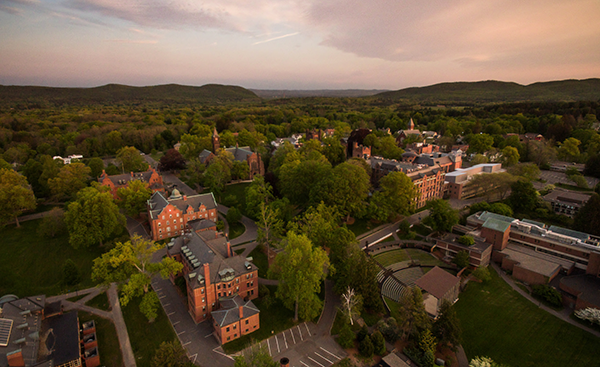








Leave a Reply